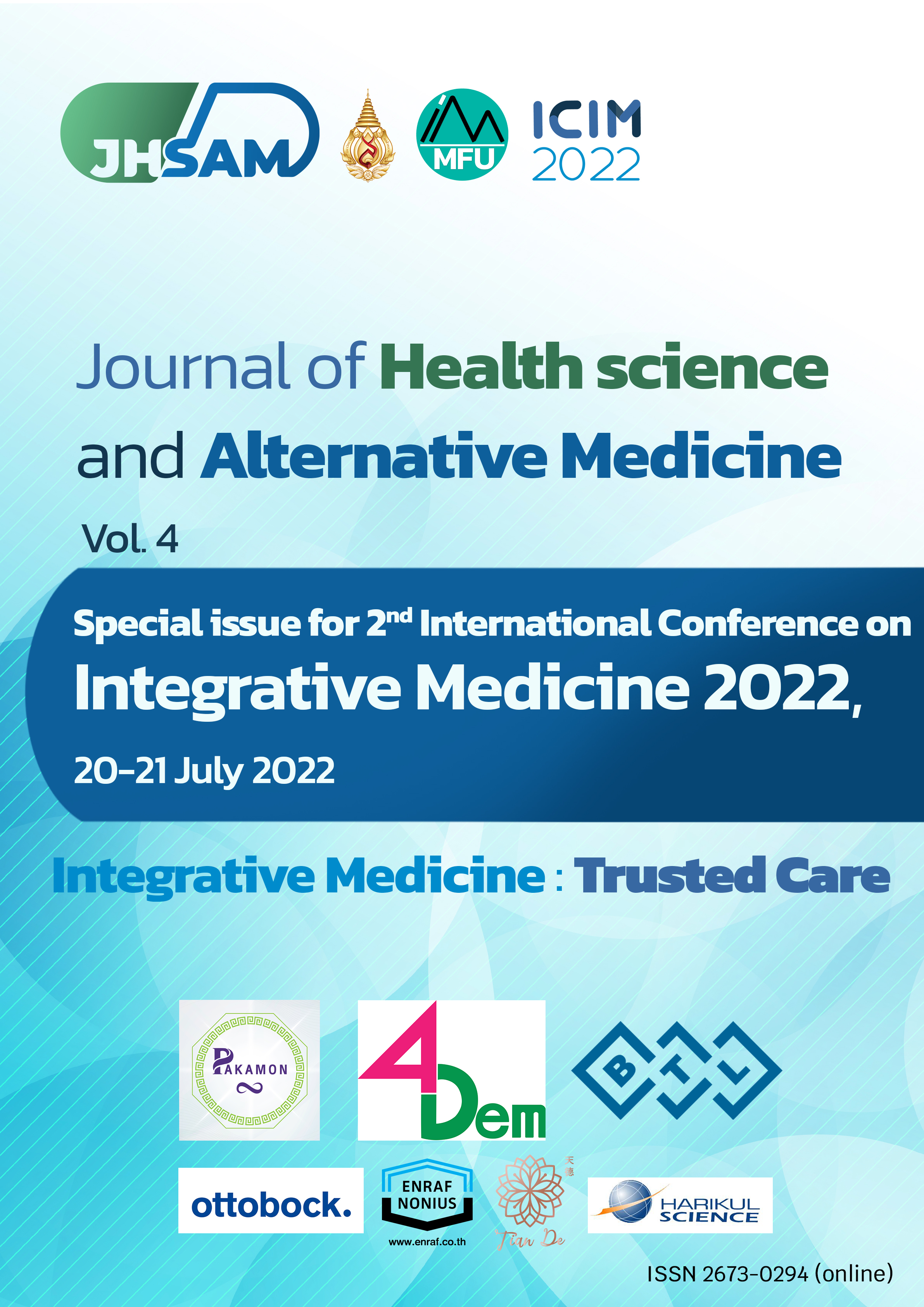D05. A comparative study for clinical efficacy and safety between a combination of fractional radiofrequency and microneedling with fractional radiofrequency alone in the treatment of striae distensae
Main Article Content
Abstract
Introduction: Striae distensae present with structural change of collagen bundles, elastolysis and cellular infiltration, that led to skin flattening, discoloration, and scarring. There is no standard treatment nowadays. Fractional radiofrequency (RF) is a radio transmission that generates thermal effect that promote wound healing effect and stimulate collagen and elastin production. Microneedling is an alternate modality that can also stimulate collagen production.
Objective: This study aimed to compare the efficacy and the safety of a combined fractional radiofrequency and microneedling versus fractional radiofrequency alone for treating striae distensae.
Methods: This was a prospective, randomized-controlled, assessor-blinded, intra-individual split-side comparative, experimental study. Inclusion criteria included all participants aged 18-50 years with Fitzpatrick’s skin type III and IV with bilateral sides of striae alba. All participants were randomly assigned to be treated with combined fractional RF and microneedling therapy on one side of the body or fractional RF alone in contralateral side for 3 sessions. The primary outcome was the Global Aesthetic Improvement Scale (GAIS). The secondary outcomes included the width and length of striaes, patient’s satisfaction’s score, and adverse events.
Results: There were 22 participants with the mean (SD) of 29 (7.8) years and 90.9% were female (n=20). The GAIS, assessed by two blinded dermatologists was significantly better improved in the combination group than fractional RF alone group at 4, 8, and 12 weeks (p < 0.05). The striae width and length significantly decreased in both groups without significant differences. There was no difference in patient’s satisfaction score at week-12 visit between the 2 groups. Common adverse event included post-inflammatory hyperpigmentation (PIH) (36.4%) in the combination group and (27.3%) in fractional RF alone group without significant difference.
Conclusion: A combination of fractional radiofrequency and microneedling had better clinical efficacy in term of GAIS than fractional radiofrequency alone in treating striae distensae.
Article Details

This work is licensed under a Creative Commons Attribution-NonCommercial-NoDerivatives 4.0 International License.
JHSAM publishes all articles in full open access, meaning unlimited use and reuse of articles with appropriate credit to the authors.
All our articles are published under a Creative Commons "CC-BY-NC-ND 4.0". License which permits use, distribution and reproduction in any medium,
provided that the original work is properly cited and is used for noncommercial purposes.
References
Chang, A.L, Agredano, Y.Z, Kimball, A.B. Risk factors associated with striae gravidarum. J Am Acad Dermatol. 2004;51(6): 881-885.
Cho, S, Park, E.S, Lee, D.H, Li, K, Chung, J.H. Clinical features and risk factors for striae distensae in Korean adolescents. J Eur Acad Dermatol Venereol.2006;20(9): 1108-1113.
Di lernia, V, Bonci, A, Cattania, M, Bisighini, G. Striae distensae (rubrae) in monozygotic twins. Pediatr Dermatol. 2001;18(3): 261-262.
Jiménez, G.P, Flores, F, Berman, B, Gunja-smith , Z. Treatment of striae rubra and striae alba with the 585-nm pulsed-dye laser. Dermatol Surg. 2003;29(4): 362-365.
Savas, J.A, Ledon , J.A, Franca, K, Nouri, K. Lasers and lights for the treatment of striae distensae. Lasers Med Sci. 2014;29(5): 1735-1743.
Watson , R.E, Parry, E.J, Humphries, J.D, Jones , C.J, Polson, D.W. Fibrillin microfibrils are reduced in skin exhibiting striae distensae. Br J Dermatol. 1998 ;138(6): 931-937.
Elsaie , M.L, Baumann , L.S, Elsaaiee , L.T. Striae distensae (stretch marks) and different modalities of therapy: an update. Dermatol Surg. 2009;35(4): 563-573.
Atiyeh, B.S, Dibo, S.A. Nonsurgical nonablative treatment of aging skin: radiofrequency technologies between aggressive marketing and evidence-based efficacy. Aesthetic Plast Surg. 2009;33(3): 283-294.
El-domyati, M, El-ammawi, T.S, Medhat, W, Moawad, O, Brennan, D.Radiofrequency facial rejuvenation: evidence-based effect. J Am Acad Dermatol.2011 ;64(3): 524-535.
Hruza, G, Taub, A.F, Collier, S.L, Mulholland, S.R. Skin rejuvenation and wrinkle reduction using a fractional radiofrequency system. J Drugs Dermatol. 2009;8(3): 259-265.
Simmons, B.J, Griffith, R.D, Falto-aizpurua, L.A, Nouri, K. Use of radiofrequency in cosmetic dermatology: focus on nonablative treatment of acne scars. Clin Cosmet Investig Dermatol. 2014;12(7): 335-339.
Bloom, B.S, Emer, J, Goldberg, D.J. Assessment of safety and efficacy of a bipolar fractionated radiofrequency device in the treatment of photodamaged skin. J Cosmet Laser Ther. 2012;14(5): 208-211.
Lee, H.S, Lee, D.H, Won, C.H, Chang, H.W, Kwon , H.H. Fractional rejuvenation using a novel bipolar radiofrequency system in Asian skin. Dermatol Surg.2011;37(11): 1611-1619.
Alster, T.S, Graham, P.M. Microneedling: A Review and Practical Guide.Dermatol Surg. 2018;44(3): 397-404.
Pellicane, B. Microneedling: clinical applications (chapter 7). In: Hausauer, A.K(ed.) PRP and Microneedling in Aesthetic Medicine. Stuttgart: Thieme Medical Publishers Inc; 2019. p. 58–69.
Fatemi naeini, F, Behfar, S, Abtahi-naeini, B, Keyvan, S, Pourazizi, M. Promising Option for Treatment of Striae Alba: Fractionated Microneedle Radiofrequency in Combination with Fractional Carbon Dioxide Laser. Dermatol Res Pract.2016;2016(2896345).
Seong, G.H, Jin, E.M, Ryu, T.U, Kim, M.H, Park, B.C. Fractional Radiofrequency Microneedling Combined With Fractional Carbon Dioxide Laser Treatment for Striae Distensae. Lasers Surg Med. 2021 ;53(2): 219-226.
Ryu, H.W, Kim, S.A, Jung, H.R, Ryoo, Y.W, Lee, K.S. Clinical improvement of striae distensae in Korean patients using a combination of fractionated microneedle radiofrequency and fractional carbon dioxide laser. Dermatol Surg.2013;39(10): 1452-1458.
Pongsrihadulchai, N, Chalermchai, T, Ophaswongse, S, Pongsawat, S, Udompataikul , M. An efficacy and safety of nanofractional radiofrequency for the treatment of striae alba. J Cosmet Dermatol. 2017;16(1): 84-90.
Yang, Y.J, Lee, G.Y. Treatment of Striae Distensae with Nonablative Fractional Laser versus Ablative CO(2) Fractional Laser: A Randomized Controlled Trial. Ann Dermatol. 2011;23(4): 481-489.

